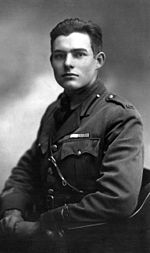Portal:Literature/Selected work/3
"Big Two-Hearted River" is a two-part short story written by American author Ernest Hemingway, published in the 1925 Boni & Liveright edition of In Our Time, the first American volume of Hemingway's short stories. It features a single protagonist, Hemingway's recurrent autobiographical character Nick Adams, whose speaking voice is heard just twice. The story explores the destructive qualities of war which is countered by the healing and regenerative powers of nature. When it was published, critics praised Hemingway's sparse writing style and it became an important work in his canon.
The story is one of Hemingway's earliest pieces to employ his Iceberg Theory of writing; a modernist approach to prose in which the underlying meaning is hinted at, rather than explicitly stated. "Big Two-Hearted River" is almost exclusively descriptive and intentionally devoid of plot. Hemingway was influenced by the visual innovations of Cézanne's paintings and adapted the painter's idea of presenting background minutiae in lower focus than the main image. In this story, the small details of a fishing trip are explored in great depth, while the landscape setting, and most obviously the swamp, are given cursory attention.

